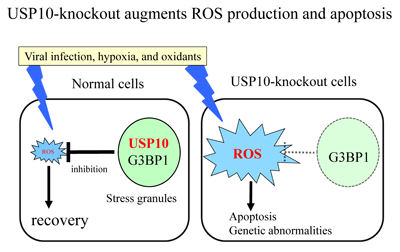Virology
HOME > Activities > Basic Medicine > Virology
1.Research Summary
In the field of virology, we conduct research on the pathogenesis of leukemia and myelopathy by human T-cell leukemia virus 1 (HTLV-1) infection and the therapies against these diseases.
2.Research Subjects
- HTLV-1 pathogenesis of leukemia and myelopathy
- Mechanism of leukemia stem cell survival and maintenance
- Treatment targeting leukemia stem cells
- Mechanism for control of stress response by stress granules
- Mechanism for control of active oxygen species production and carcinogenesis
- Pathogenesis of leukemia due to Ras route abnormality
3.Research Results
|
[Area] Virology |
|
|
[Research subject] Pathogenesis of leukemia due to HTLV-1 |
|
|
[Description] |
[Photographs]
|
|
[Area] Virology |
|
|
[Research subject] Mechanism for control of stress response by stress granules |
|
|
[Description] |
[Photographs]
|
Please see the Virology website for a detailed description of our research.


